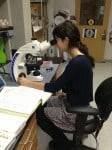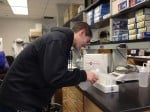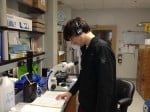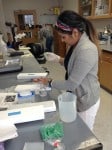Update from the UMD Lab
February 18, 2013
From: Bee Informed
by Rachel Bozarth
Beekeeping this time of year in the Northeastern US is practically nonexistent. Honey bees cluster around their queen in their hives as below freezing temperatures, wind, and snow challenge their survival. Opening the hive in these kinds of conditions would be setting yourself up for failure. Winter this year in Maryland has been very unpredictable. For instance, just last week we experienced a 65 degree day and the next day the temperature dropped and we had snow on the ground. I originally thought that our diagnostic lab would experience a lag in receiving samples, but man was I wrong!
In other parts of the country the temperatures are more pleasant and the honeybees have a shorter overwintering period. In California, for example, it would not be unusual to see bees flying in January (in Maryland we see this only once in a ‘blue moon’ on those rare warmer days). The tech transfer team in CA has been hard at work in the apiaries of commercial queen breeders. We began receiving samples from them in mid-January so we have been processing them for Nosema and Varroa and cranking out reports to the beekeepers ever since.
Meanwhile, the spring semester at the University of Maryland is now underway. In between processing BIP samples, I have been teaching a new batch of undergrads how to check for Nosema spores under the microscope. They are continuing a project from last semester that focused on checking individual bees for Nosema rather than an aggregate sample of 100. For more information about this project see my blog from December-http://beeinformed.org/2012/12/undergraduate-research-in-the-vanengelsdorp-lab/
This semester we are welcoming Eva Bein, Tyler Connine, Ghonva Ghauri and Julius Goldberg. Julius worked with us last semester so he is becoming the team lead for this group of undergrads and we are glad to have him back. Who knows, one of them could become a future star of honey bee research…




Leave a Comment